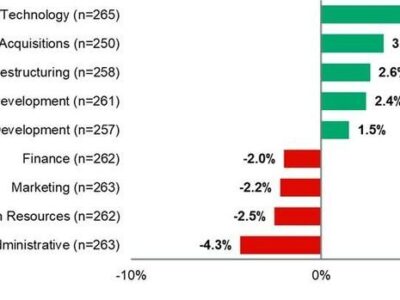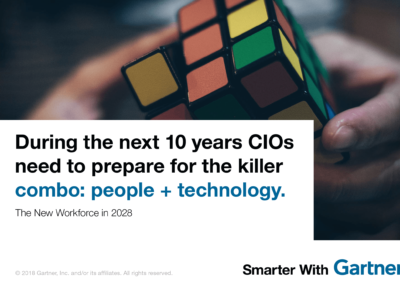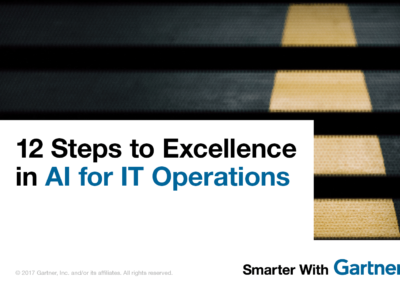Can learnings from early projects give CIOs a head start with AI technologies?
CIOs are struggling to accelerate deployment of artificial intelligence (AI). A recent Gartner survey of global CIOs found that only 4% of respondents had deployed AI. However, the survey also found that one-fifth of the CIOs are already piloting or planning to pilot AI in the short term.
Such ambition puts these leaders in a challenging position. AI efforts are already stressing staff, skills, and the readiness of in-house and third-party AI products and services. Without effective strategic plans for AI, organizations risk wasting money, falling short in performance and falling behind their business rivals.
“Pursue small-scale plans likely to deliver small-scale payoffs that will offer lessons for larger implementations”
“AI is just starting to become useful to organizations but many will find that AI faces the usual obstacles to progress of any unproven and unfamiliar technology,” says Whit Andrews, vice president and distinguished analyst at Gartner. “However, early AI projects offer valuable lessons and perspectives for enterprise architecture and technology innovation leaders embarking on pilots and more formal AI efforts.”
So what lessons can we learn from these early AI pioneers?
Aim for fairly “soft” outcomes, such as improvements to processes, customer satisfaction, products and financial benchmarking
When Gartner Research Circle respondents were asked what lessons they had learned from early AI projects, many urged others not to fall into the trap of seeking only immediate monetary gains. They advised instead to aim initially for less quantifiable benefits from which financial gains would eventually arise. These might come from “softer” or more “open” outcomes, such as improved marketing or brand identity, or they could lead to wider benefits altogether.
Of course, some companies need to demonstrate financial benefit in order to initiate an AI project. In such cases, it makes sense to pursue small-scale plans likely to deliver small-scale payoffs that will offer lessons for larger implementations.
Read more: The CIO’s Journey to Artificial Intelligence
Focus on worker augmentation, not worker replacement
AI’s potential to reduce staff head count attracts the attention of senior business executives as a potential cost-saving initiative. A more informed expectation, however, would be for applications that help and improve human endeavors, as AI promises benefitsfar beyond automation. Organizations that embrace this perspective are more likely to find workers eager to embrace AI.
“Lack of staff and skills to conceive and execute AI projects is a significant obstacle to progress for many organizations.”
“Research Circle members said that the people who are actually on the frontline are really excited about being able to have this additional information available to them during that process to determine if we want to take that risk on or not,” says Andrews. “They’re certainly not cowering in the corner, afraid that AI will replace them. They’re absolutely embracing it, saying they can make much better decisions with this additional information.”
Plan for the transfer of knowledge from external service providers and vendors to enterprise IT and business workers
Lack of staff and skills to conceive and execute AI projects is a significant obstacle to progress for many organizations, so external service providers can play a key role in planning and delivering AI-powered software.
When using an external service provider, executives are adamant — knowledge transference is crucial. Organizations need to plan for the transfer of knowledge from external service providers and vendors to enterprise IT and business workers throughout the execution of projects. This will ensure that the internal skills are available to develop similar capabilities in the future.
Read more: How to Tell When Vendors Are Hyping AI Capabilities
Choose AI solutions that offer means of tracking and revealing AI decisions
It’s important to opt for AI solutions that offer means of tracking and revealing AI decisions — ideally using action audit trails and features that visualize or explain results. To that end, Gartner predicts that by 2022, enterprise AI projects with built-in transparency will be twice as likely to receive funding from CIOs.
“One AI pioneer noted that workers need to be able to explain the basis of their decisions and require decision support that reveals the rules and processes that led to particular recommendations,” explains Andrews. “If he predicts that something will fail, the immediate question someone asks is ‘Why is it going to fail?’ He said having the transparency will help him explain how he came to that conclusion.”

Gartner clients can read more in the report “Lessons From Early AI Projects,” by Whit Andrews and Jim Hare. This research is part of the Gartner Special Report “Craft an Artificial Intelligence Strategy,” a collection of research aimed at helping CIOs incorporate AI into their strategic planning and evaluation processes for business transformation.
Get Smarter
Managing Risk and Security at the Speed of Digital Business
Digital business challenges the basic principles of information risk and security management. Risk and security leaders must understand…
Cloud Computing Primer
Cloud computing, in its many forms, has become an integral part of IT. Even after 10 years of cloud hype, confusion is still rampant….
Follow #GartnerCIO
Learn more at Gartner Global Summits and Gartner Symposium/ITxpo.










